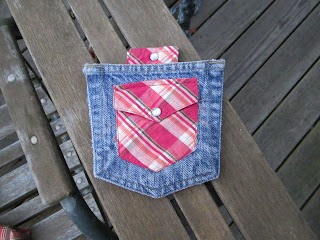
For your cover pieces, cut two strips, 6" by 10" -- also cut a strip of interfacing 6" by 10".
For your pocket pieces, cut three contrasting strips, 4 1/2" by 7".

On your pocket strips, press under about 1/4" on the short end. Then press lengthwise each one forms a double-thick piece, 2 1/4" by 6 3/4".

Put your first pocket strip in place on top of the interfacing and one cover strip (save the other cover strip for later.) Make sure the folded edge is pointing up and it'll be about 1 1/2" from the top raw edges. Align the raw edges on the left, and have the folded-under edge on the right side. Stitch close to the raw edges along the bottom of the strip.

Lay your second pocket strip on top of the first, just moving the folded edge down; stitch the raw edge into place. Do the same with the third strip.

You can see here how the pockets are forming. Stitch along the left-hand edge (the folded-under pocket edges, through all thicknesses). I also used a straightedge to mark my middle row of stitching.

I actually ended up doing two rows of stitching down the middle, because I thought it might make it fold easier when full, but I don't think it makes that much difference.

Layer your pocket assembly with the other cover strip, wrong sides together. Cut a curved edge through all three layers (two fabrics, one interfacing) - you can see the fancy guide I used!

Apply bias binding. I cut my strip 1 1/2" wide, and pressed under 1/4" on the edge that would later be hand-stitched onto the other side. This is just an ordinary quilt binding technique, and made a much tidier edge than trying to turn it inside-out. It does need to be bias, so it'll go smoothly over that curved edge.

Binding done!

Now, just choose a button and make a buttonhole. Be careful when stitching the button on - you'll want to reach inside the pocket so you don't stitch it closed.


Six teabags, ready to roll.
Here's the quickie version out of a shirt cuff. I just moved the buttons in and did a very narrow zigzag stitch to join the edges together.

I forgot to take photos of the door draft stopper before I mailed it off, but Maureen will send me one later. In the meantime, here's a video I found that explains the buttonhole stitch technique I mentioned (also known as blanket stitch) - so handy!


























































